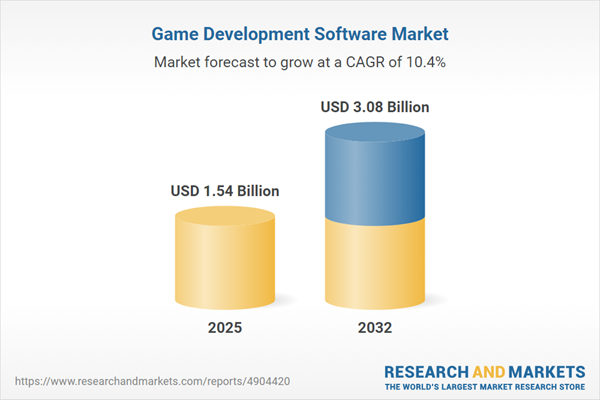Speak directly to the analyst to clarify any post sales queries you may have.
The game development software market is advancing swiftly, shaped by innovation, expanding user bases, and evolving content platforms. Senior leaders face heightened complexity as technology, regulation, and global trends converge, requiring informed, agile decision-making.
Market Snapshot: Game Development Software Market Overview
The Game Development Software Market grew from USD 1.39 billion in 2024 to USD 1.54 billion in 2025. It is expected to continue growing at a CAGR of 10.44%, reaching USD 3.08 billion by 2032.
Scope & Segmentation
- Engine Types: 2D Engine, 3D Engine (Custom Engine, Unity Engine, Unreal Engine), AR Engine, VR Engine
- Component Types: AI Module, Audio Module, Graphics Module (2D Renderer, 3D Renderer), Physics Module
- Deployment Modes: Cloud Based, On Premises
- License Types: Freemium Model, Open Source, Perpetual License, Subscription License
- End Users: Educational Institutions (Higher Education, K-12), Independent Developers, Large Enterprises, Small and Medium Enterprises
- Regions & Select Countries: Americas (United States, Canada, Mexico, Brazil, Argentina, Chile, Colombia, Peru), Europe (United Kingdom, Germany, France, Russia, Italy, Spain, Netherlands, Sweden, Poland, Switzerland), Middle East (United Arab Emirates, Saudi Arabia, Qatar, Turkey, Israel), Africa (South Africa, Nigeria, Egypt, Kenya), Asia-Pacific (China, India, Japan, Australia, South Korea, Indonesia, Thailand, Malaysia, Singapore, Taiwan)
- Key Players: Unity Technologies ApS, Epic Games, Inc., Autodesk, Inc., Adobe Inc., Microsoft Corporation, Crytek GmbH, Amazon.com Inc., Cocos (Shanghai) Network Technology Co., Ltd., Valve Corporation, NVIDIA Corporation
Key Takeaways
- Cross-platform compatibility and AI-driven innovation are now essential for software providers aiming to streamline workflows and reduce development cycles.
- Cloud computing is setting new standards for real-time collaboration, allowing teams to develop and deploy projects efficiently regardless of geography.
- Modular architectures and extensible plug-in ecosystems support scalability and flexibility, enabling swift response to changing user expectations and project scopes.
- Democratization of robust development tools is expanding access, leading to increased competition and accelerating advancements in visual and AI capabilities.
- Regional disparities influence product adoption and go-to-market strategies, necessitating localized support, adaptive licensing, and compliance with varying data sovereignty mandates.
Tariff Impact
Recent United States tariffs have influenced both hardware procurement and software licensing across global supply chains for game development software. Many studios are adapting by shifting capital planning, favoring cloud-based rendering over hardware reliance. Asset distribution and outsourcing strategies are adapting to increased cross-border costs, while providers are refocusing on flexible license models that support diverse client requirements. Regional talent sourcing and hybrid cloud approaches help mitigate exposure to regulatory shifts and cost volatility.
Methodology & Data Sources
This report incorporates structured primary interviews with technology leaders, supported by surveys across organizational scales. Secondary research draws on technical publications, industry forums, patent analysis, and regulatory documents. Quantitative licensing metrics are synthesized with qualitative feedback on workflow and adoption trends, producing actionable insights for the sector.
Why This Report Matters
- Enables leadership teams to anticipate market shifts, optimize investment, and remain adaptive in a rapidly evolving technology environment.
- Highlights regional opportunities and compliance considerations essential for formulating localization or expansion strategies.
- Delivers insights to support joint ventures, product innovation, and informed procurement, all tailored to senior decision-maker priorities.
Conclusion
Senior decision-makers benefit from clarity on technological, regulatory, and strategic forces shaping the future of game development software. Leveraging modular tools, adaptive licensing, and global insights positions market participants to respond decisively to industry change.
Additional Product Information:
- Purchase of this report includes 1 year online access with quarterly updates.
- This report can be updated on request. Please contact our Customer Experience team using the Ask a Question widget on our website.
Table of Contents
3. Executive Summary
4. Market Overview
7. Cumulative Impact of Artificial Intelligence 2025
Companies Mentioned
The companies profiled in this Game Development Software market report include:- Unity Technologies ApS
- Epic Games, Inc.
- Autodesk, Inc.
- Adobe Inc.
- Microsoft Corporation
- Crytek GmbH
- Amazon.com, Inc.
- Cocos (Shanghai) Network Technology Co., Ltd.
- Valve Corporation
- NVIDIA Corporation
Table Information
| Report Attribute | Details |
|---|---|
| No. of Pages | 181 |
| Published | October 2025 |
| Forecast Period | 2025 - 2032 |
| Estimated Market Value ( USD | $ 1.54 Billion |
| Forecasted Market Value ( USD | $ 3.08 Billion |
| Compound Annual Growth Rate | 10.4% |
| Regions Covered | Global |
| No. of Companies Mentioned | 11 |









